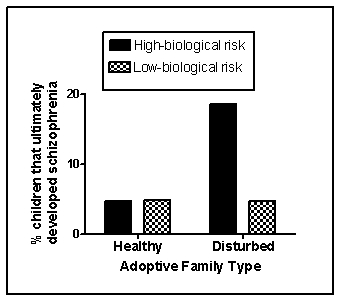Scenario II
The following scenario presents fabricated data consistent with the results of the following study:
Tienari, P., Wynne, L. C., Sorri, A., Lahti, I., Läksy, K., Moring, J., & ... Wahlberg, K. (2004) . Genotype-environment interaction in schizophrenia-spectrum disorder: Long-term follow-up study of Finnish adoptees. The British Journal of Psychiatry, 184(3) , 216-222. doi:10.1192/bjp.184.3.216
Schizophrenia affects approximately 1 percent of the general population and is characterized by the profound disruption of basic psychological processes; a distorted perception of reality;, altered or blunted emotional affect; and disturbances in thought, motivation, and behavior. The symptoms of schizophrenia are varied and are typically classified as either positive or negative. Positive symptoms of schizophrenia refer to thoughts and behaviors typically not observed in those without the disease, and can include things like delusions (patently false beliefs) , hallucinations (false perceptual experiences) , and disorganized speech. Negative symptoms of schizophrenia are deficits or disruptions in normal behaviors, such as social withdrawal. Cognitive deficits in executive functioning, attention span, and working memory also may be observed.
The symptoms of schizophrenia usually begin in late adolescence and the disease has a strong genetic component. Over the years, a number of biological factors have been linked to schizophrenia, although none alone adequately accounts for the disorder. One such example is the dopamine hypothesis, which states that schizophrenia is related to an excess in dopamine activity. Another theory points to enlarged brain ventricles and progressive cortex tissue loss as predictive of schizophrenia, although only a minority of persons with schizophrenia have enlarged ventricles, this structural anomaly can appear in those without the disease, and dopamine antagonists also may produce this effect.
Although research into the environmental determinants of schizophrenia has focused largely on the prenatal environment, psychological and social factors also contribute. Tienari et al. (2004) compared the risk of developing schizophrenia in children adopted into healthy versus disturbed families, the latter characterized by extreme conflict, volatile relationships, and communication deficits. Some of these children under investigation were identified as at-risk genetically for schizophrenia because their biological mothers were schizophrenic. The remainder was classified at low risk. The investigators utilized a longitudinal design and obtained the diagnostic status of the children with respect to schizophrenia when they reached young adulthood. Fabricated results consistent with this study are shown in Figure 15.2
Figure 15.2 
-(Scenario II) Which is a positive symptom of schizophrenia?
Definitions:
Upper Class
A social stratum that typically enjoys the highest status, wealth, and education in a hierarchical society.
Quantum Opportunities
Potential situations or moments that present significant possibilities for change or advancement, often with reference to quantum theory concepts.
Mentoring Program
A structured relationship in which a more experienced individual provides guidance, knowledge, and support to a less experienced person.
Funded
Having financial support or resources allocated for a specific purpose or project.
Q2: Jeremiah believes that the lead psychologist at
Q4: (Scenario II) After being suspended by his
Q4: Cognitive therapy focuses on:<br>A)identifying unconscious desires and
Q8: In one study, business executives who scored
Q24: Antidepressants are commonly used to treat not
Q62: Some people with bipolar disorder find the
Q62: Drugs used to treat psychological disorders usually
Q75: Which of these is NOT a mood
Q138: During the 1950s, drugs were discovered that
Q154: TMS is reportedly an effective and noninvasive